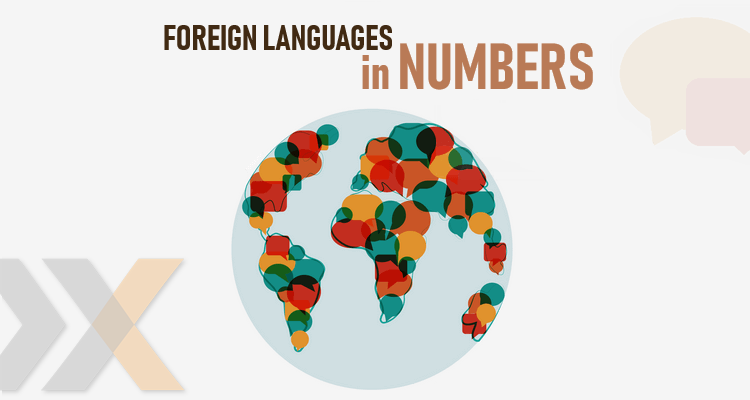Foreign languages in numbers
Simona Pralovska 10.06.2019 Meet the World with Lexika Reading time: 3 min.
10.06.2019 Meet the World with Lexika Reading time: 3 min. 
Do you know which language is the most widespread in the world? Is it Chinese, English, Arabic or some other language? The answer is not a simple one. For one thing, it depends on whether we only want to include the total number of native speakers of a particular language, or everybody speaking that language. In this article, we’ll take a look at 5 interesting statistics about languages.
The numbers are interesting and some might surprise you, so let’s take a look at them.
The most widespread language in the world...
To get a better picture of the numbers, we’ll begin with the total number of people in the world. Currently, the world population has reached about 7.7 billion people.
The following graph shows the most widespread language in the world based on three criteria: the number of native speakers, the total number of speakers, and the number of countries where the language is an official language.
(You can switch between the tabs by clicking the left/right arrow or selecting from the drop-down window.)
...based on the number of native speakers of the language
Ethnologue has considered the most widespread languages based on the number of native speakers. It found that one of the ten most widespread languages is the mother tongue for almost half the world’s population (i.e. 3.27 billion).
Other European languages rated among the top 25 are: French in 16th place (77.2 mil.), German in 17thplace (76.1 mil.) and Italian in 22nd place (64.8 mil.). Most other European languages have a place among the top 100 most widespread languages, too, including Czech and Hungarian.
...based on the total number of speakers
When we add people speaking the language to the number of native speakers, we get a completely different order of languages. This statistic includes people speaking the language as their second language.
The British Council went one step further in its survey. Its aim was to estimate the number of people having a level of English enabling basic communication. It arrived at the number of 1.75 billion people, which is nearly a quarter of the world’s population.
...based on the number of countries where the language is an official language
English plays the leading role in this chart as well. It is used as an official language in 55 countries. This is a result of British and American colonization in the past. English is also a majority language in some countries where it is not an official language (at least not now).
How many languages are there in the world?
In total, there are about 7,111 living languages in the world. A living language is language having at least one native speaker. However, the number of languages is constantly changing, as some languages are dying out and new ones are emerging. By the time you read this article, the exact number of languages may be different.
It is interesting to look at how these languages are distributed throughout the world. Just for comparison: there are 288 languages in Europe, whereas in Papua New Guinea (with a population similar to Austria’s) people speak up to 840 languages. In practice, this means that when you meet two people in Papua New Guinea, they are very likely to speak different mother tongues. For those who like numbers: according to Greenberg’s Diversity Index, this probability is 98.8 % (in the UK, for example, it is 15.4 %).
If you want to see for yourself, or to count the languages, we’re including a detailed map of the world with the following distribution of languages:
Around the third of all languages are so-called endangered languages, with most of them having fewer than 1,000 speakers. A few years ago, there was a rumour that there was a language in Mexico – Ayapaneco – which was on the verge of extinction because the only two people speaking it were refusing to talk to each other. Luckily, it turned out that this was just a myth.
The most-studied languages
It comes as no great surprise that the prize for ‘the most-studied language’ goes to English, followed closely behind by languages closer to us – at least geographically.
1. English
2. French
3. Spanish
4. Italian
5. Chinese
6. Japanese
7. German
Asian languages are on the rise, though, so the order might change in the near future.
Did any of these statistics surprise you? Are you interested in further information on languages? Let us know in the comments!
Zdroje:
https://www.ethnologue.com/
https://iso639-3.sil.org/code_tables/639/data?title=&field_iso639_cd_st_mmbrshp_639_1_tid=All&name_3=&field_iso639_element_scope_tid=All&field_iso639_language_type_tid=51&items_per_page=200
https://www.britishcouncil.org/sites/default/files/english-effect-report-v2.pdf
https://www.mosalingua.com/en/most-studied-languages-in-the-world/

I began my journey at LEXIKA during my university days in 2017. LEXIKA, the people that form part of it, and the translation industry have grown on me since then. One of the day-to-day challenges I have to face is finding new talented translators. Furthermore, I take care of developing good and open relationships with our long-standing translators who make it possible for us to do what we love. Over time, I was put in charge of marketing activities and internal HR. I don’t have to worry about my job turning into a daily grind and I learn something new every day. :)
Share it!